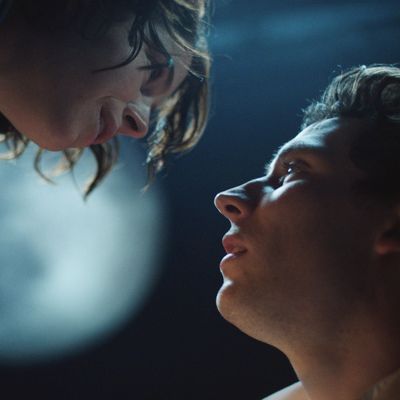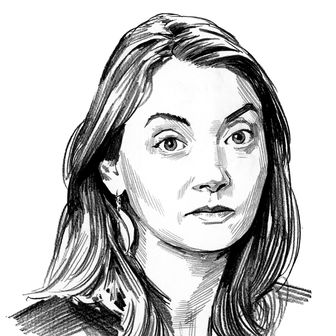
In an interview with the Folger Shakespeare Library about his film adaptation of Romeo and Juliet, the director Simon Godwin described the tragedy as a “plague play.” A plague play? I checked the title. Was he still talking about Shakespeare’s horniest teen tragedy? Stabbings and poison are the main dangers in Shakespeare’s story, and the star-crossed Veronese only wear masks when they’re going to a masquerade. But according to Godwin, if you look deep enough, you see the plot hinges on disease. At a crucial instant late in the play, we’re told a messenger couldn’t enter a quarantined town — so a letter is lost, a plan is lost, a boy is lost, a girl is lost. Godwin’s TV adaptation of Shakespeare’s tragedy touches on our current pandemic in the same profound but hidden, offstage way. In his fever-dream chamber version, no one ever mentions COVID, but our plague is still there, crowding and compressing every image, setting each event in motion.
Originally, Godwin’s modern-dress production was scheduled for London’s National Theatre as a normal part of its normal season. When the city shut down, the stage production was reimagined as a film, a first for both Godwin and the NT. It was shot in an almost bare theater, which the team turned into the play’s whole world. There’s hardly a set — one room, the rest simply props — but the movie’s textures are surprisingly luxurious. To make up for the forbidden outside, cinematographer Tim Sidell comes up with inventive ways to shoot the Lyttelton stage as if it is a ballroom (bodies crowd the camera), a dark garden (a huge moon drifts out of focus in the background), and an Italian alleyway raked with sun (characters huddle on a little path behind a plywood wall).
First, though, the film starts with the full cast, 14 people in rehearsal clothes, sitting together on the prop-strewn stage. They are getting ready, and they soon launch into a dry run of the show’s first fight scene. As a few men mark the swordplay with wooden batons, the other cast members look on placidly. Suddenly, an actor takes an unplanned swing, pulls a real knife, and the ensemble erupts — “Hey! Hey!” they cry, swarming forward to pull the two quarreling performers apart. The camera itself seems to be fighting too. When the scrum clears, we’ve crossed over from one kind of pretending into another — it’s a bravura transition, one so physically thrilling I watched it again and again.
Despite its iambic pentameter and theatrical setting, the adaptation is totally at home in its final televised format (it’s being broadcast as part of PBS’s Great Performances). It winds up looking quite like TV’s current crop of luscious the-kids-aren’t-all-right dramas: With its high-angle close-ups and shallow depth of field, Romeo & Juliet fits in with neurotically sensual shows like Euphoria and Normal People. It’s full, too, of familiar faces from our everything-is-television age: Josh O’Connor, the icy young Prince Charles on The Crown, is the dreamy Romeo; Jessie Buckley from Fargo and I’m Thinking of Ending Things plays a stunning, thoughtful, angry Juliet. Sidell’s filming strategy relies on filling the theater with smoke, and the resulting candlecore blurriness captures the drowsiness of our languishing year. The foggy air seems heavy. Lucian Msamati pronounces the play’s prologue, which tells us about what will concern the “two hours’ traffic of our stage.” There’s something very 2021 about the fact that the movie actually only runs for 90 minutes. Who could bear a full two hours’ traffic? Not us, not now.
You’d think a pared-down script of such a well-known play would be a highlights reel, a page from Bartlett’s Familiar Quotations. But Godwin and his adapter, Emily Burns, take their razor to the most recognizable lines: Almost every couplet is out (sorry, “story of more woe”), and light no longer breaks soft through yonder window. The naughty Nurse (Deborah Findlay) and Mercutio don’t make the dirty jokes that your English teacher had to explain — their puns are all cut. The show is thus emotionally familiar but textually surprising. It sounds just about as modern as something 500 years old can sound. Godwin may be directing for a screen for the first time, but he’s a longtime expert at helping actors inhabit verse, and each member of the superb cast swims easily in the language — the meter pulses through them, and every thought is clear.
If many of the lines you remember are out, so are the lines for all the characters you’ve forgotten. (The great Adrian Lester plays the Prince, and he barely gets to say anything at all.) Shakespeare’s original surrounds his young nobles with chattering servants, who war in the street on behalf of their masters, and staff who grumble about their canceled gigs. But Godwin isn’t interested in context and class irony; he’s interested in love and how, in our touch-starved isolation, every contact can be electric. We only really see scenes that result in some kind of contact, and if two characters so much as graze each other, they start to sway. (When people fantasize about the summer after COVID, this is what they’re picturing.) Libido drives everything: Lady Capulet (Tamsin Greig) tells her kinsman Tybalt (David Judge) to stop annoying people at her party, and their eyes catch, their breathing changes. The frequent brawls tie the men into wriggling, erotic knots that only untie when someone dies. Even Romeo’s friends Benvolio (Shubham Saraf) and Mercutio (Fisayo Akinade) are caught up in this production’s romantic intoxication, gazing into each other’s faces as they try, fumblingly, to find some privacy.
Godwin and editor Nick Emerson double and triple any moments of contact with quick flashes forward and backward in time. They emphasize and reemphasize Buckley and O’Connor’s sweet chemistry: Romeo and Juliet’s first kiss at the Capulets’ ball is multiplied, showing us the yet-to-come wedding night as well as the actors’ eyes meeting in rehearsal. There are certain costs to these choices. By slicing away so much surrounding material, O’Connor’s Romeo becomes a much more troubling character — he becomes less the romantic hero than the dangerous boy-man, self-pitying and too eager with a knife. And thanks to certain flashes of their tragic future, the pair both seem death-obsessed, their readiness to kill themselves seemingly always front-of-mind.
Yet this air of moral and mental fragility also makes it the right Romeo & Juliet for the pandemic era. It captures our shutdown claustrophobia — overheated, narcissistic, a little damaged. And just as the last year has done, it warps our experience of time. An odd coincidence of the filming strategies and Michael Bruce’s constant, propulsive underscoring make it seem a little weightless, rather like a trailer or a series of music videos, rather than the main event itself. Its 90 minutes fly breathlessly by. After it was over, I wondered if I should watch it again: I had hoped it would sink its fingers into me, but instead it delivered only teasing, promising touches. But that too is a credit to the way Godwin has made a 500-year-old play into a mirror of our own everyday. I lived through that time, I know I did. But the memory of it has turned into a dream already.
Great Performances: Romeo & Juliet will be on PBS starting April 23.


